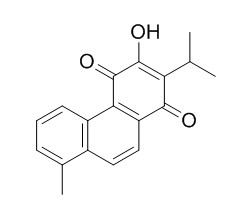Danshenxinkun B
Danshenxinkun B has antioxIdant activity, it may have the potential of being used as natural antioxidants in foods and cosmetics.
Inquire / Order:
manager@chemfaces.com
Technical Inquiries:
service@chemfaces.com
Tel:
+86-27-84237783
Fax:
+86-27-84254680
Address:
1 Building, No. 83, CheCheng Rd., Wuhan Economic and Technological Development Zone, Wuhan, Hubei 430056, PRC
Providing storage is as stated on the product vial and the vial is kept tightly sealed, the product can be stored for up to
24 months(2-8C).
Wherever possible, you should prepare and use solutions on the same day. However, if you need to make up stock solutions in advance, we recommend that you store the solution as aliquots in tightly sealed vials at -20C. Generally, these will be useable for up to two weeks. Before use, and prior to opening the vial we recommend that you allow your product to equilibrate to room temperature for at least 1 hour.
Need more advice on solubility, usage and handling? Please email to: service@chemfaces.com
The packaging of the product may have turned upside down during transportation, resulting in the natural compounds adhering to the neck or cap of the vial. take the vial out of its packaging and gently shake to let the compounds fall to the bottom of the vial. for liquid products, centrifuge at 200-500 RPM to gather the liquid at the bottom of the vial. try to avoid loss or contamination during handling.
Processes2021, 9(11),2065.
Molecules.2021, 26(9):2526.
Journal of Ginseng Research2022, j.jgr.2022.09.005.
Plant Growth Regulation2020, 90(2):383-392
Molecules.2024, 29(5):1048.
Biomedicines.2022, 10(3):583.
Drug Invention Today2019, 12(6):1303-1306
Tokyo Pharmaceutical University2020, 500001431953.
J. Soc. Cosmet. Sci. Korea2021, 47(1):57-63
Pharm Biol.2021, 59(1):134-145.
Related and Featured Products
J. Agr. Food Chem., 1990, 38(5):1194-7
Antioxidative components of tanshen (Salvia miltiorrhiza Bung).[Reference:
WebLink]
METHODS AND RESULTS:
Rhizomes of tanshen (Salvia miltiorrhiza Bung) were pulverized and extracted with diethyl ether. The extract was washed with 5% sodium carbonate solution, freed of solvents, and applied to a silica gel column. Seven colorful bands ranging from light yellow to dark brown were resolved and collected. After certain purification procedures, such as stepwise recrystallization and preparative TLC, seven crystalline quinone-type compounds were obtained, namely tanshinone I, dihydrotanshinone I, tanshinone IIA, tanshinone IIB, methylenetanshinquinone, cryptotanshinone, and Danshenxinkun B, all of which had color. Confirmation of the identifications was carried out by mass spectroscopy and infrared spectrometry. Measurement of the antioxidant activity in lard of these quinones was performed with two methods, the Rancimat method and the Shaal oven method in conjunction with peroxide value determination. Except for tanshinone IIA, all the quinones exhibited antioxidant activities, of which dihydrotanshinone I, tanshinone I, methylenetanshinquinone, and cryptotanshinone showed strong activities comparable to that of BHA and BHT.
CONCLUSIONS:
These compounds may have the potential of being used as natural antioxidants in foods and cosmetics.
J Chromatogr A. 2001 Aug 3;925(1-2):109-14.
Preparative isolation and purification of six diterpenoids from the Chinese medicinal plant Salvia miltiorrhiza by high-speed counter-current chromatography.[Pubmed:
11519796]
METHODS AND RESULTS:
A high-speed counter-current chromatography (HSCCC) method was developed for the preparative separation and purification of six diterpenoids. dihydrotanshinone I, cryptotanshinone, methylenetanshiquinone, tanshinone I, tanshinone IIA and Danshenxinkun B from the Chinese medicinal plant Salvia miltiorrhiza Bunge. The crude diterpenoids were obtained by extraction with ethanol-n-hexane (1:1, v/v) from S. miltiorrhiza Bunge. Preparative HSCCC with the two-phase solvent systems A composed of n-hexane-ethanol-water (10:5.5:4.5, v/v) and B composed of n-hexane-ethanol-water (10:7:3, v/v) was successfully performed in a stepwise elution yielding six relatively pure diterpenoids from 300 mg of the crude extract in a single run.
CONCLUSIONS:
The purities of dihydrotanshinone I, cryptotanshinone, methylenetanshiquinone, tanshinone I, tanshinone IIA and Danshenxinkun B were 88.1, 98.8, 97.6, 93.5, 96.8 and 94.3%, respectively.
《Acta Pharmaceutica Sinica》 1988-04
A NEW DITERPENOID QUINONE DEHYDROMILTIRONE[Reference:
WebLink]
METHODS AND RESULTS:
A new diterpenoid quinone dehydromiltirone (Ⅰ), and three known compounds miltirone (Ⅱ), Danshenxinkun B (Ⅲ), danshenxinkun D (Ⅳ), were isolated from the roots of Salvia prionitis Hance for the first time.
CONCLUSIONS:
All of them are minor constituents of the plant and their identification is based on spectral analysis.



